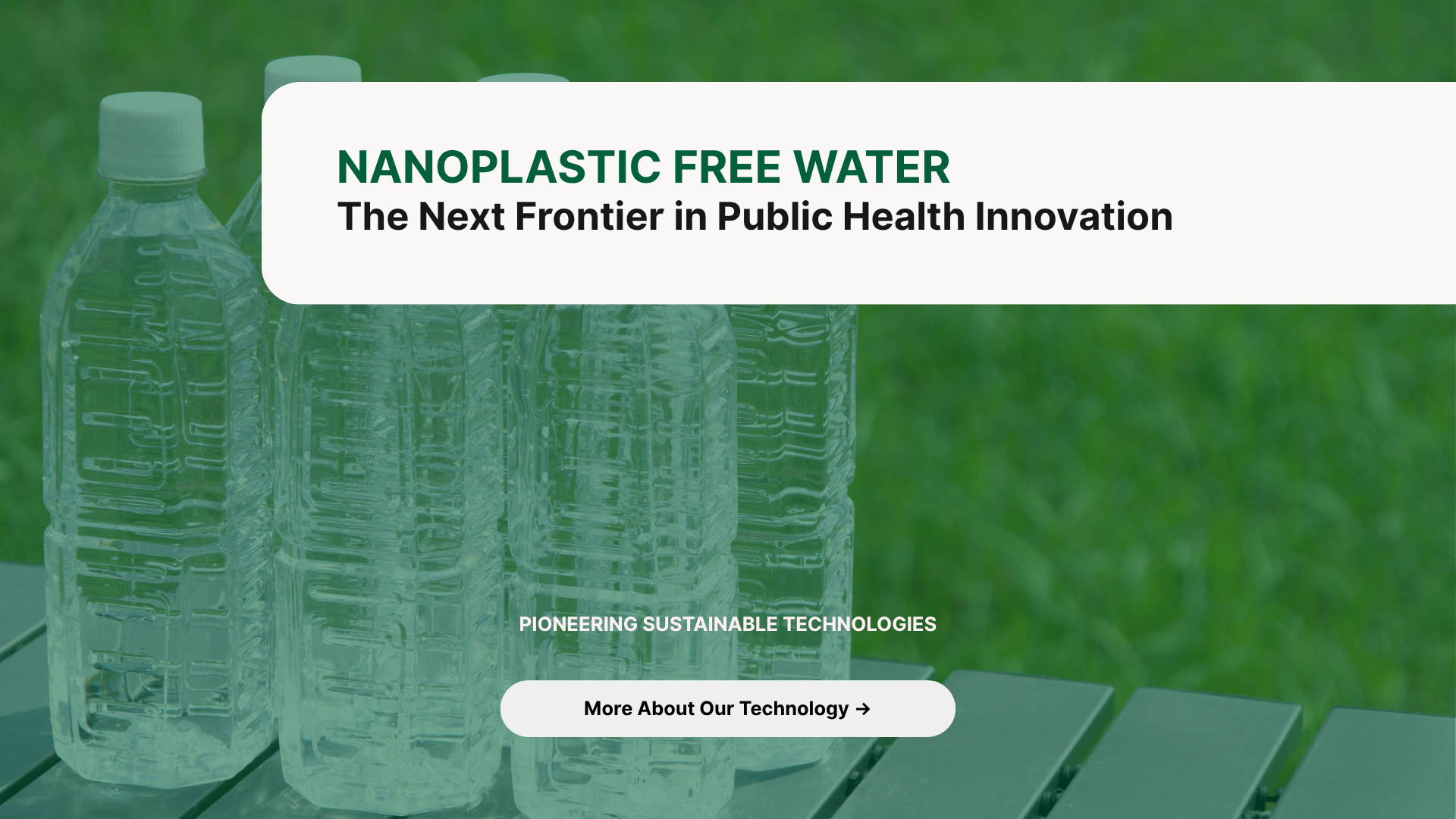Why nanoplastic free water matters now.
Access to safe water is a core public health objective. New evidence shows that bottled water, widely used by families and institutions, contains very large numbers of plastic particles. Many of these particles are nanoplastics that are small enough to cross biological barriers and enter organs. Public health agencies, universities and hospital networks are now reporting these findings in accessible summaries and news releases that any reader can verify. The priority is clear. We need reliable ways to lower exposure, and packaging reform is central to that task. Nanoplastic free water packaged in certified biodegradable water bottles is becoming a practical route for health services, schools and consumers who want measurable risk reduction.
What nanoplastics in water are and how exposure occurs.
Nanoplastics are plastic fragments smaller than one micrometre. Their size allows them to move through intestinal walls and lung tissue and to circulate in blood. Consumer exposure occurs during daily hydration because common polymers used for beverage packaging shed particles during production, transport and storage. Thermal stress from warm cars, direct sun and long shelf time increases the rate of particle release. This is not conjecture. It is measured with modern spectroscopy and newly refined optical methods that can count very small particles in complex liquids.
What the most accessible studies report.
A research team linked with Columbia University reported that a single litre of bottled water can contain between one hundred and ten thousand and three hundred and seventy thousand particles, with the majority in the nano range. This report is summarised on the Columbia public health site and is accessible to the public. UCLA Health also published a clinician facing explainer that cites the same magnitude of contamination and clarifies why nanoplastics are an exposure concern for patients and families. The United States National Institutes of Health covered the detection of large numbers of plastic fragments in bottled water in its public news channel NIH Research Matters, again in accessible language for non specialists. These sources are written for broad audiences and can be opened without subscription. They establish the scale of the issue and confirm that nanoplastics in water are not a rare event but a routine feature of bottled products.
Sources, Columbia Public Health, UCLA Health, NIH Research Matters. See full links in References.
Why nanoplastics in water raise medical concerns.
Plastic particles are not inert. Their surfaces attract and transport organic contaminants and metals. Particles also carry residual monomers and additives used during polymer manufacture. Health researchers now document three broad mechanisms that justify precaution.
First, inflammation. Foreign particles trigger immune responses in gut and vascular tissues. This can raise baseline inflammation and disrupt normal repair signals.
Second, endocrine interaction. Plastic additives can interact with hormone receptors or interfere with the enzymes that regulate hormone levels.
Third, tissue penetration. The small size of nanoplastics allows entry into cell interiors and through sensitive barriers, including the blood brain barrier, where they can disturb cellular processes.
These mechanisms are consistent with clinical and pathological findings. A study in the New England Journal of Medicine reported micro and nano sized plastic particles inside atheroma plaques in human arteries. Patients with detectable particles in plaques had a higher risk of adverse cardiovascular outcomes. The abstract page is public and readable. A report in ScienceAlert summarised the clinical risk estimate for wide audiences and confirms that the observed risk uplift was large. These converging findings support the argument that reducing routine ingestion of particles is a reasonable public health action while deeper research continues.
Sources, NEJM abstract and ScienceAlert coverage. See links in References.
Why nanoplastic free water depends on packaging reform.
Water quality standards focus on biological and chemical contaminants. Particle contamination from packaging is a newer field and is not yet captured by routine compliance testing. That is why nanoplastic free water is not only a question of the source water. It is a question of the container. Conventional PET and similar polymers shed fragments during moulding, filling, capping, transport and storage. Even when recycling systems improve, particle shedding during use remains. The most direct exposure control is to change the materials we use for packaging and to verify particle release under realistic conditions.
What makes a water bottle truly nanoplastic free.
Claims alone are not sufficient. A credible nanoplastic free water solution requires four elements.
One, independent testing for particle release under common storage and thermal conditions.
Two, toxicology screening for both the material and its breakdown products, including soil safety after disposal.
Three, full end of life disclosure that confirms no microplastic or nanoplastic residue remains.
Four, compatibility with current distribution systems so that hospitals, schools and retailers can use the solution without major process change.
Certified biodegradable water bottles that use controlled depolymerisation can meet these criteria. The bottle performs like a conventional container in use, then breaks down into non toxic compounds in landfill conditions. This avoids long term fragmentation into microplastics and nanoplastics, and removes the burden from imperfect recycling systems. Where certification is provided by recognised bodies and supported by published test results, procurement teams can treat such packaging as a risk control, not a marketing claim.
Public health benefits of nanoplastic free water in real settings.
Health services, schools and emergency programs rely on packaged water for surge needs and safety. In these settings small improvements in exposure control compound quickly because usage volumes are high. Moving to nanoplastic free water in certified biodegradable bottles supports four practical outcomes that matter for managers and clinicians.
Lower ingestion of particles during routine hydration.
Clear documentation for procurement audits and ESG reporting.
Reduced landfill persistence and lower risk of particle release after disposal.
Removal of methane and toxic residue generation when the bottle decomposes.
Because these benefits are tied to packaging performance rather than consumer behaviour, they are durable across regions with different recycling capacity.
Policy and regulation are moving toward particle control.
Public awareness and investor scrutiny are now pushing regulators to consider particle release as a material risk. The European Commission has advanced rules that require clearer information about product composition and end of life behaviour. Health systems are adding plastic exposure to their sustainability plans. Universities and journals are publishing lay summaries that help non specialists understand the evidence. These actions do not rely on fear. They rely on accessible facts and verifiable results. As this policy shift strengthens, suppliers that deliver nanoplastic free water in certified biodegradable water bottles will gain smoother access to public tenders and international trade.
Implementation guidance for brands and institutions.
Move with simple steps that build scientific credibility.
Select packaging with third party verification for zero particle residue after end of life.
Request test reports that show very low or no particle release during storage, heat exposure and transport.
Align labels and claims with consumer law guidance to avoid greenwashing risk.
Use procurement language that prefers certified biodegradable water bottles for high volume use.
Disclose results openly to customers and staff to build trust.
These steps prepare organisations for future rules that will likely require particle release control and full life cycle reporting.
Conclusion, a measurable path to safer hydration.
Nanoplastics in water are now measured and widely reported by public sources. The number of particles in bottled products is large, and medical literature now links plastic particles in human tissues with adverse outcomes. The most constructive response is practical. Move to nanoplastic free water and use certified biodegradable water bottles that remove the particle pathway at its source. This approach fits public health priorities, aligns with procurement practice and reduces long term environmental load. It turns a complex scientific finding into a clear, evidence based action.
Key Summary
✓ Bottled water can contain from one hundred and ten thousand to three hundred and seventy thousand particles per litre, with most in the nano range
✓ Public sources from Columbia Public Health, UCLA Health and NIH confirm the scale of particles in bottled water and explain the health context
✓ Medical literature reports plastic particles inside human arterial plaques and links presence to higher cardiovascular risk
✓ Nanoplastic free water depends on packaging reform, not only on source water quality
✓ Certified biodegradable water bottles cut exposure during use and leave no particle residue after disposal
✓ Clear testing, certification and open disclosure create trust for hospitals, schools and retailers
✓ Policy and investor pressure are moving markets toward particle control and full life cycle reporting
Tags: nanoplastics in water, nanoplastic free water, biodegradable water bottles, microplastics health, public health strategy, bottled water risk, ESG procurement, landfill safety, particle testing, The Eco Bottle
References with public access
Columbia University Mailman School of Public Health. Bottled water can contain hundreds of thousands of nanoplastics. https://www.publichealth.columbia.edu/news/bottled-water-can-contain-hundreds-thousands-nanoplastics
UCLA Health. Truth about nanoplastics in bottled water.
https://www.uclahealth.org/news/article/truth-about-nanoplastics-bottled-water
NIH Research Matters. Plastic particles in bottled water. https://www.nih.gov/news-events/nih-research-matters/plastic-particles-bottled-water
The New England Journal of Medicine, Abstract page. Microplastics and nanoplastics in atheromas. https://www.nejm.org/doi/abs/10.1056/NEJMoa2309822
ScienceAlert. Report on plastic found in plaques and associated risk. https://www.sciencealert.com/plastic-found-inside-more-than-50-of-plaques-from-clogged-arteries

